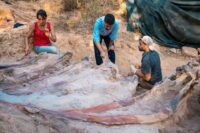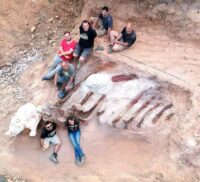 In a scene reminiscent of the opening credits of the Flintstones, a gigantic rack of ribs from a Late Jurassic sauropod has been unearthed at Monte Agudo in the Pombal region of Portugal. If preliminary calculations prove accurate, this could be the largest dinosaur specimen ever found in Europe.
In a scene reminiscent of the opening credits of the Flintstones, a gigantic rack of ribs from a Late Jurassic sauropod has been unearthed at Monte Agudo in the Pombal region of Portugal. If preliminary calculations prove accurate, this could be the largest dinosaur specimen ever found in Europe.
Fragments that turned out to be from dinosaur bones were first encountered by the owner when he was doing some home renovations in March of 2017. He reported the find to scientists at the University of Lisbon who did a few initial surveys at that time. A joint team of Portuguese and Spanish paleontologists returned last month to fully excavate the Monte Agudo site and hit paydirt: large sections of the axial skeleton of a likely brachiosaurid sauropod, including vertebrae and all of the ribs, the largest of which are ten feet long. They date to the Late Jurassic era, around 145 million years ago
 It is extremely rare for Brachiosauridae fossils to be found in such good condition and still in their original anatomical locations instead of scattered. The skeleton’s comparative completeness allowed researchers to extrapolate the animal’s size from the bones that have survived. It was approximately 39 feet tall and 82 feet long.
It is extremely rare for Brachiosauridae fossils to be found in such good condition and still in their original anatomical locations instead of scattered. The skeleton’s comparative completeness allowed researchers to extrapolate the animal’s size from the bones that have survived. It was approximately 39 feet tall and 82 feet long.
The preservation characteristics of the fossils and their disposition indicate the possible presence of other parts of the skeleton of this individual, a hypothesis that will be tested in future excavation campaigns in the deposit.
“The research in the Monte Agudo paleontological locality confirms that the region of Pombal has an important fossil record of Late Jurassic vertebrates, which in the last decades has provided the discovery of abundant materials very significant for the knowledge of the continental faunas that inhabited the Iberian Peninsula at about 145 million years ago,” adds Elisabete Malafaia.
The mineralized bones were removed to a laboratory for meticulous removal of stone and sediments. Once fully liberated from their context, the bones will be studied further and eventually put on display in a museum.